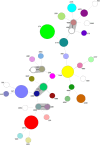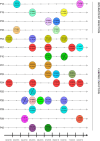Unveiling the molecular epidemiology of Pseudomonas aeruginosa in lung infections among cystic fibrosis patients in the Brazilian Amazon
- PMID: 40205346
- PMCID: PMC11984257
- DOI: 10.1186/s12866-025-03920-w
Unveiling the molecular epidemiology of Pseudomonas aeruginosa in lung infections among cystic fibrosis patients in the Brazilian Amazon
Abstract
Background: Pseudomonas aeruginosa is a major pathogen in cystic fibrosis (CF), where chronic and intermittent infections significantly affect patient outcomes. This study aimed to investigate the molecular epidemiology of P. aeruginosa in CF patients from the Brazilian Amazon, focusing on genotypic diversity, resistance profiles, and virulence factors.
Methods: A cross-sectional study included 72 P. aeruginosa isolates from 44 CF patients treated at a regional reference center between 2018 and 2019. Antimicrobial susceptibility patterns were determined using VITEK-2 system and Kirby-Bauer disk diffusion. Virulotypes were defined by molecular detection of exoS, exoU, exoT, exoY, algU, and algD genes. Genetic diversity was assessed using multilocus sequence typing (MLST). Demographic data, clinical severity, and spirometry results were also collected.
Results: Among the patients, 54.55% experienced intermittent infections, while 45.45% had chronic infections. Chronic infections were associated with older age, lower FEV1, and reduced Shwachman-Kulczycki scores. Multidrug resistance was observed in 15.3% of isolates, particularly against ciprofloxacin and piperacillin/tazobactam. The exoU gene was present in 55.56% of isolates, an uncommon finding in CF populations. High genetic diversity was evident, with 37 sequence types (STs), including 14 novel STs. High-risk clones (HRCs) constituted 25% of isolates, with ST274 being the most prevalent (12.5%). Longitudinal analysis revealed transient colonization in intermittent infections, while chronic infections were dominated by stable clones.
Conclusion: This study highlights the molecular and clinical dynamics of P. aeruginosa in CF patients from the Brazilian Amazon. Chronic infections were linked to severe lung impairment , while intermittent infections were dominated by HRCs. These findings underscore the need for robust genotypic surveillance to mitigate the burden of P. aeruginosa in CF populations.
Keywords: Pseudomonas aeruginosa; Antimicrobial Resistance; Brazil; Genotyping; Virulence.
© 2025. The Author(s).
Conflict of interest statement
Declarations. Ethics approval and consent to participate: The samples included in this study were obtained during routine laboratory procedures at the CF reference center. Consent for participation was obtained from all included patients upon written signature of informed consent form. All data collection and experiments related to this study were performed in accordance with Brazilian guidelines and regulations (Resolution CNS nº 196/96), as well as the Declaration of Helsinki. This study was approved by the Ethics Committee of the HUJBB/UFPA (Approval no. 1.910.716) and was registered with the National System for the Management of Genetic Heritage and Associated Traditional Knowledge (SisGen; registration no. AF44CCB). Consent for publication: Not applicable. Competing interests: The authors declare no competing interests.
Figures


Similar articles
-
Antimicrobial resistance, virulence gene profiling, and genetic diversity of multidrug-resistant Pseudomonas aeruginosa isolates in Mazandaran, Iran.BMC Microbiol. 2024 Dec 28;24(1):546. doi: 10.1186/s12866-024-03707-5. BMC Microbiol. 2024. PMID: 39732629 Free PMC article.
-
Integron types, antimicrobial resistance genes, virulence gene profile, alginate production and biofilm formation in Iranian cystic fibrosis Pseudomonas aeruginosa isolates.Infez Med. 2018 Sep 1;26(3):226-236. Infez Med. 2018. PMID: 30246765
-
The exoS, exoT, exoU and exoY Virulotypes of the Type 3 Secretion System in Multidrug Resistant Pseudomonas aeruginosa as a Death Risk Factor in Pediatric Patients.Pathogens. 2024 Nov 22;13(12):1030. doi: 10.3390/pathogens13121030. Pathogens. 2024. PMID: 39770290 Free PMC article.
-
Emerging strategies to target virulence in Pseudomonas aeruginosa respiratory infections.Crit Rev Microbiol. 2024 Nov;50(6):1037-1052. doi: 10.1080/1040841X.2023.2285995. Epub 2023 Nov 24. Crit Rev Microbiol. 2024. PMID: 37999716 Review.
-
A systematic review and meta-analysis on Exo-toxins prevalence in hospital acquired Pseudomonas aeruginosa isolates.Infect Genet Evol. 2019 Nov;75:104037. doi: 10.1016/j.meegid.2019.104037. Epub 2019 Sep 10. Infect Genet Evol. 2019. PMID: 31518698
References
MeSH terms
Substances
Grants and funding
LinkOut - more resources
Full Text Sources
Medical
Molecular Biology Databases

